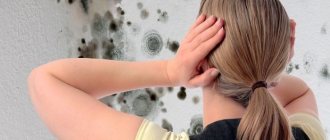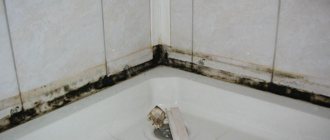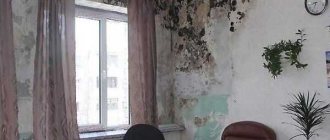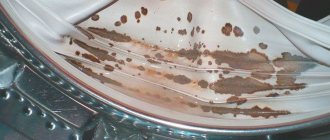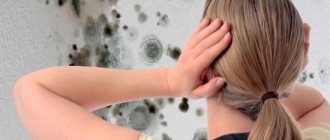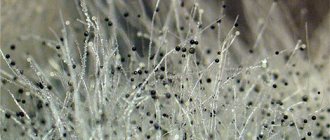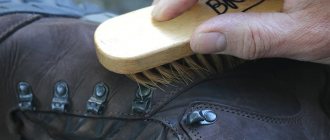My refugee friend is still without the Internet, so I’m writing on her behalf. They returned home today, from where they fled literally in what they were wearing, in slippers and dressing gowns from the bombing. The dishes with food were left there; after two months they dried out and became moldy.
The question is - can it be washed off from mold and what is the best way, or is it better to throw it away immediately? She also has other dishes, but she also doesn’t want to throw them away in the current financial climate.
For mold to appear on dishes, it is enough for them to stand unwashed for some time, with food leftovers, in a warm place. If plates, pots, cups, pans and other utensils are washed, there is simply nothing for the fungus to feed on them. But if you still forgot to wash something, and then saw a black coating inside the dishes, don’t be upset. Mold deposits can be removed using hot water, detergents and chemicals. It is most difficult to combat mold on unglazed ceramic surfaces.
Deliverance Plan
You can get rid of mold in dishes using:
- vinegar;
- soda;
- hydrogen peroxide 3%;
- laundry soap;
- liquid detergents.
All this should be accompanied by a kitchen sponge, wire scrubbers and hot water.
Processing methods depend on the type of dishes and your material and technical base. If you have a dishwasher at home, the task becomes much easier. It is enough to remove visible mold from the dishes (scrape off the remaining food, as is always done in this case), load everything into the machine and start the appropriate washing mode.
But it may also happen that there is no hot water tap in the house. Then the water is boiled directly in a saucepan or other moldy container.
In case of massive mold damage, experienced housewives advise wiping everything with paper (old newspapers can be found everywhere), putting it in a boiling pot, pouring water with a strong solution of baking soda, putting it on the stove and letting it boil for at least half an hour.
Boiling with boiling water and soda is very helpful if you need to wash a large amount of dishes - it works like a dishwasher.
In addition, boiling water kills fungi on all materials, including porous ones. Metal utensils are boiled separately from breakable ones.
Is it possible to wash dishes with soda ash?
There are two types of soda: baking soda and ash. Both substances contain sodium, baking soda contains sodium bicarbonate, and soda ash contains sodium bicarbonate. Baking soda is used in cooking. It is completely safe for the human body. Soda ash is not used; it is a technical product. The substance can be used for industrial purposes, for washing. The product contains a large amount of alkali, it easily copes with stains and dirt of any type. Soda ash can be used to treat all types of dishes; it does not leave behind toxic substances and perfectly removes odors and outdated plaque. The main condition is to use rubber gloves when working with the substance, otherwise you risk getting a skin burn.
The article has been verified by the editors
How to get rid of mold smell in a saucepan.
Wipe with a sponge soaked in vinegar, let dry, then wash with hot water.
If there is mold in a cup, it is first washed to remove visible deposits, then filled with hydrogen peroxide or vinegar and allowed to stand. After this, wash under running hot water with detergent.
Another algorithm for action if mold is found in a mug or cup: make a paste from baking soda and apply it to the dishes after the initial wash. Let it sit until the soda dries, then wash it again. This treatment also removes the unpleasant odor.
The specificity of earthenware is that it cannot be calcined on the stove by adding water. But the oven will help: initially washed pots or jugs, cups or plates are filled with cold water, placed in the oven, and then heated in the same way as when heating milk.
It is not recommended to use liquid detergents to wash clay products, especially unfired ones.
Mold that has appeared in a clay teapot is removed as follows: after removing the bloomed tea leaves, the teapot must be washed well, wiped and put in the oven. Heat at maximum temperature, leaving to cool inside, then wash well again.
When mold is found in a cupboard with dishes, table vinegar will help get rid of it: a sponge is moistened with vinegar essence, after which all surfaces of the furniture are wiped. To prevent fungus from settling on dish shelves, do not place dry dishes in the closet.
Where else can you use oil?
Massage is one of the most popular ways to use essential oils. Massaging with a few drops helps the remaining oils to be absorbed more easily and have a beneficial effect on the skin. Try using a hot or cold compress. To do this, you need to wet the cloth and add a little oil to it. The towel is applied to the area for 10-15 minutes. This method is used to treat and eliminate muscle spasms, headaches and joint pain.
Try adding the oil (up to 10 drops) to a hot bath before taking it. You can also use the fragrant product in a foot bath to eliminate fatigue and pain after a hard day. It's no secret that essential oils help fight fungal infections, but they should be used along with other antiseptics.
“Olga” from the series of the same name: the tragic fate of actress Yana Troyanova
The star of the series “Sultan of My Heart” spoke about the choice of his future wife
25 children of a childless man: an extraordinary reunion
Manifestations
Mold can grow almost anywhere where the conditions are right for it. Fungus on a wall or windowsill is easy to recognize: first small black dots or spots appear, which later turn into large affected areas. Mold often colonizes kitchen walls and bathroom tiles.
Mold can manifest itself as a damp, unpleasant “basement” smell, similar to the smell of an old book. But it is not a reliable indicator of the presence of fungus, because, for example, if it is present behind wallpaper, it may be barely noticeable.
How is it harmful?
Not all types of branching mycelium are hazardous to health. The only dangerous fungi are those that produce volatile organic compounds (VOCs). Black mold is one of them. The VOCs it produces lead to the release of histamine in human immune cells, which can lead to lung diseases such as asthma.
This problem can become a real nightmare. Its exposure can lead to immediate or delayed reactions, so the true cause of a particular disease is not always immediately obvious.
Black mold in the bathroom provokes the following symptoms:
- dizziness;
- respiratory problems;
- flu symptoms;
- body pain and aches;
- skin rash;
- sinusitis;
- fungal infections;
- pulmonary ailments;
- depression;
- irritability;
- cough, etc.
If family members often get sick for no apparent reason, it is worth inspecting the bathroom and other rooms for microscopic spores.
Actions to take when a fungus appears
Dry damp walls, for example after a flood or prolonged water leakage, as soon as possible using an electric dryer. Prolonged humidity increases the risk of mold development.
Hot air dryers are also used in a closed room. Place them 70-100cm from the wall so that the warm air flowing in one narrow direction does not dry out the walls faster than the surrounding area, causing subsequent cracking. During drying, it is necessary to ensure the necessary air exchange so that when windows and doors are opened, warm air passes to the top of the room or to the upper floor. Move the dryer every 8 hours to ensure the walls dry evenly.
Eliminating the cause of fungus
By taking a closer look at the situation indoors or outdoors, it is quite possible to determine the cause of mold formation:
- External causes include water entering the building through cracks in the brickwork, poor insulation, flooding and rain.
- Internal causes - the cause is usually poorly made thermal insulation or its absence, internal water condensation.
- Moisture from mechanically damaged structures – damaged or leaking water supply system, cracked pipelines.
Important! Do not try to remove large areas of mold with chemicals. The fungus will disappear fairly quickly, but will return just as quickly.
If you can't remove mold from paint or wallpaper, remove it. But this must be done very carefully; it is better to contact specialists. In this process, it is practically impossible to prevent the massive spread of spores into the environment. One option that experts suggest for removing black mold from walls is to irradiate the affected area with ultraviolet, gamma or microwave radiation.
Contacting a specialist is also required if you do not see mold, but smell it. The expert will be able to determine the “secret” location of the fungus.
What dangers does mold pose?
Some people are sensitive to mold and may experience symptoms such as nasal congestion, eye irritation, allergic reaction (itching, rash, redness), difficulty breathing. But people who are allergic to mold may have a serious reaction, including shortness of breath or fever. When kept in a poorly ventilated area, especially for a long period, mold can cause infectious diseases in the lungs, since spores during breathing enter primarily this organ. This is especially important for those who are suffering from (or have already had) respiratory infections.
When toothpaste is harmful to children: permissible age doses
A broken nail is no problem: tips for treating nails at home
The newlyweds traveled all over the world and took wedding photos in every country
Research has shown that exposure to mold can have detrimental effects on one's lifestyle. Thus, people suffering from asthma will experience a deterioration in their general condition, as well as an increase in coughing attacks and shortness of breath. During the work, scientists found that children are much more susceptible to respiratory diseases when they are in an infected room. In the future, chronic viral diseases can cause both bronchitis and asthma, because the respiratory system suffers first.
Methods for eliminating fungus
If the affected area is small, you can clean the mold off the walls yourself. There is no need to buy expensive detergents; you can remove mold with the products you have on hand.
Antiseptic primer
In particular, in old houses there are places on the walls where, with the advent of damp weather, mushrooms regularly appear. This is usually due to the fact that these areas are colder than surrounding areas, hence more water deposits on them.
If for some reason it is impossible to properly insulate or insulate the facade from the outside (which is most effective), we can treat the mold-affected walls with special preparations. Concentrated disinfectants that destroy mold, fungi, lichens, algae, and bacteria, suitable for internal treatment, will help.
Apply disinfection in accordance with the instructions to the affected areas, and before drying, mechanically remove the applied layer with a spatula. Once the coating has dried, repeat application 1-2 times.
Walls treated in this way are painted with paint containing mold growth inhibitors.
Bleach
This product is a ruthless enemy of any type of mold. Use it to clean tiles, glass, plastic, floors. But keep in mind that it may change the color of things. Caution is also important: the substance evaporates quite dangerous toxins, and upon contact with skin can cause severe irritation. When eliminating fungus, ventilate the room.
Prepare a solution of water and bleach (10:1), use it to treat moldy surfaces, and leave to dry.
Vinegar
Vinegar acts as a mild acid - it kills 99% of bacteria, 82% of mold, 80% of viruses. Vinegar is one of the best ways to remove mold from your washing machine. But it is suitable for almost any place in the house, in particular, it is a safe option for treating children's toys - it helps clean mold from a doll or toy car.
Use white distilled vinegar. Pour it into a spray bottle and apply to the contaminated surface. Leave for 1 hour, then rinse with clean water and leave to dry. The smell of vinegar will disappear after a few hours (if it persists, you can refresh the room with lemon water).
Hydrogen peroxide
Everyone uses this product to disinfect wounds and scratches. But did you suspect that hydrogen peroxide is considered the safest natural disinfectant? This is the only disinfectant consisting of only water and oxygen. Like ozone, it kills pests by oxidation! Peroxide is considered the best way to remove mold from plastic windows.
Just spray it on the mold, leave it on for 10 minutes, wipe it off. A few drops of peroxide in water for watering flowers will prevent the development of mold on the leaves.
Ammonia
Ammonia also works well against mold and helps wipe off mold on windows and tiles.
The solution is prepared by mixing ammonia with water (1:1). A few hours after spraying the solution onto the stain, rinse it off with water.
Important! Do not combine ammonia with chlorine-containing products - this combination induces a chemical reaction with the release of toxic gases.
An invaluable natural remedy that can wash away mold on walls is baking soda. It can be used alone, in combination with water or vinegar. After application, leave the baking soda to act for 15 minutes, then wipe the treated area with a damp cloth.
Baking soda is mild but has good disinfectant properties, making it ideal for use in almost all areas of the home, including the bathroom.
This natural cleaning product has a wide range of uses in the household - from the production of organic household detergent to the effective fight against mold. The use of borax does not have a toxic effect on the environment or human health. However, caution is required when handling this substance.
Mix borax (1 tbsp.) with water (3.5 l). Apply the solution to the surface affected by mold and wipe with a brush. Then wipe the surface with a cloth and leave to dry completely. No rinsing required.
Tea tree oil
100% tea tree oil is the most powerful natural antiseptic. It is invaluable for treating skin infections, minor burns, minor wounds, and acne. But this oil is extremely effective in inhibiting bacteria and destroys mold spores that infect homes.
Characteristics and composition
The oil is obtained from the leaves of the tea tree, which grows in Australia. The method of production is steam distillation . When using high-quality raw materials and following the technology, the result is a transparent light yellow or light olive fluid liquid with a spicy woody aroma.
If the aroma contains the smell of camphor, then the oil is not natural.
The composition of the oil is complex - it includes more than 95 components, about 50% of which are monoterpenes. It is they who give it valuable properties:
- bactericidal,
- anti-inflammatory,
- warming.
The main active ingredients are terpinen-4-ol and cineole. In order for the effect of the ether to be balanced and bring only benefits, the recommended content should be 40% and 5%, respectively.
In addition, the composition contains the substances viridifloren (up to 1%), B-terpineol (0.25%), L-ternineol and alligexanoate (in the form of traces), which are rarely found in nature. Viridofloren enhances the bactericidal effect of the oil.
The antibacterial effect is so high that it is used instead of carbolic acid and phenol to disinfect premises.
How to make tiles shine
Add 15 grams of citric acid to a glass of warm water and wipe the tiles with this solution. Then rinse with warm water.
Vinegar can clean even the dirtiest tiles. Spray the surface with vinegar from a spray bottle, wait 10 minutes and rinse with clean water. Then wipe the tiles with a soft microfiber cloth. Using this method, you will clean and disinfect your walls.
Prevention
Every woman knows at least one recipe for how to remove mold in the bathroom. But this is such a complicated procedure that sometimes you have to use several products or completely change the tiles and wallpaper. In order not to bring the room to this state, it is better to prevent the growth of fungus.
This can be done if you follow certain rules. How to deal with mold:
- Make the environment unfavorable for its growth. Colonies of single-celled fungi thrive on damp surfaces, especially in dark, warm cracks. You can start by simply letting light into the room by opening the curtains.
- Maintain the humidity level, it should be below 60%. Some air conditioners allow you to set the humidity level, otherwise you can buy a meter to monitor it.
- Good ventilation is necessary. While taking a shower, steam accumulates on the surface of tiles and wallpaper. If you do not wipe the tiles after swimming, you will need to remove the spores later. You can turn on the fan or open the door slightly to prevent condensation from collecting.
- Keep fewer hygiene products in the bathroom. Shampoos and conditioners, razors, shaving gels, salts, washcloths, sponges, cups, toys and other items left indoors provide good conditions for spore growth. Buy a cabinet for them and always keep them dry.
- Wash rugs and towels frequently.
- Regularly clean your bathing area with products that will not endanger the health of your family or the environment.
- Beware of abrasive products. Abrasive cleaners can cause surfaces (tiles, wallpaper) to wear out faster, which also makes walls and tiles more susceptible to the growth of harmful scourges.
- Use a shower curtain, and wash or replace it frequently.
These are the simplest and simplest ways to prevent the growth of bacteria in the room for water treatments.
Microscopic spores spread very quickly along walls and tiles. If cleansing is not carried out in time, they may move to other rooms of the apartment. Therefore, it is worth doing a thorough cleaning of the bathroom once a week to prevent the growth of fungus.
Is it possible to add bleach to the washing machine?
It is not recommended to add bleach to your washing machine, as sodium hypochlorite reacts with the metal and can thereby shorten the life of your appliance. You should also read the operating instructions for your household appliance; it will probably indicate whether this type of product can be used. If you can’t do without whiteness,
You can soak things in its solution in advance, then simply rinse and wash.
How to make a bath snow-white
Hydrogen peroxide will help remove limescale and yellow stains. Pour it into a spray bottle, spray it over the surface of the bath, wait for an hour and rinse with warm water.
You can easily clean the surface of the bathtub by first sprinkling baking soda on it, waiting a few minutes, then pouring vinegar on it. Then carefully clean the surface with a brush and rinse with warm water.
Citric acid solution effectively removes yellow stains. To prepare the solution, stir a packet of citric acid in a cup of water. Apply the mixture with a sponge to the surface of the bath, wait 20 minutes and then rinse with warm water.
What happens if you eat moldy food?
But what if you didn't notice that your apple or bread was moldy before you took a big bite? When it comes to mold ingestion, you need to worry about the potential toxins that may be lurking inside. The mold itself probably won't be a problem. But the toxin it produces is the problem.
These mold-produced toxins are called mycotoxins and include a family of toxins called aflatoxins. Which are associated with liver cancer. Mycotoxins can be compared to poisonous snake venom. Except that its effect lasts longer.
The negative effects of mycotoxins do not occur with a single oral dose. Instead, these harmful effects accumulate in the body over time.
So even if you feel fine after eating a moldy piece of food, mycotoxins can accumulate in your body.
Caring for enamel equipment
Adapting to the pan, we cook everything in it, but this is unacceptable for enamel cookware. This product is intended for preparing liquid dishes, kisses and compotes. Proper use guarantees long-term use.
If the housewife is preparing pasta or porridge that has stuck to the bottom, there is a desire to quickly wash off the slag from below with a stiff brush. These actions irreversibly destroy the pan, so it is strictly forbidden to use metal or sharp abrasive materials when cleaning burnt-on food.
